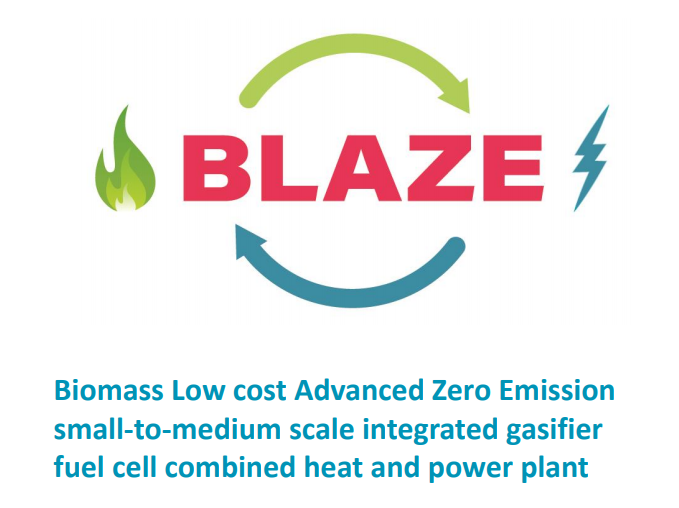First results of the BLAZE project: biomass low cost advanced zero emission small-to-medium scale integrated gasifier fuel cell CHP plant - ISSUE #1
CONTEXT At present, installed electricity generation capacity by Combined heat and power (CHP) in the EU-28 is about 120 GWe, which generates approximately 11% of the EU electricity demand (362 TWh, i.e. on average ≈3000 annual equivalent hours). The CHP heat capacity is about 300 GWth with a heat production of 775 TWh, i.e. an average of ≈2.5 thermal/electrical power ratio and 2500 annual equivalent hours. Renewables, mainly biomass and in particular low-cost biomass or biomass waste, are becoming increasingly important after having attained 20% of the market. Bioenergy has currently the largest share (88%) of all RES used for heat and cooling with 76 Mtoe, not far from the 2020 Member States plan of 90 Mtoe. OBJECTIVES BLAZE aims at developing an innovative highly efficient and fuel flexible small and medium-scale biomass CHP technology consisting of a compact bubbling fluidised-bed gasifier integrating primary sorbents and ceramic candle filters with Ni catalyst (IBFBG), a high temperature fixed bed sorbents reactor and an integrated solid oxide fuel cell (SOFC) including first-of-a-kind heat-driven gas recirculation. The technology is developed for a CHP capacity range from 25-100 kWe (small scale) to 0.1-5 MWe (medium scale) and is characterized by the widest fuel spectrum applicable (forest, agricultural and industrial waste also with high moisture contents, organic fractions of municipal waste, digestate), high net electric (50%) and overall (90%) efficiencies as well as almost zero gaseous and PM emissions; the CO2 production is neutral, while the other emissions are zero or negligible. In fact, gasification, with respect to other biomass conversions, can convert a greater variety of solid biomass with shorter residence time and higher efficiency into a gaseous fuel that, when converted via fuel cells, can achieve the highest overall (90% versus 65% now) and electrical CHP efficiencies for small and medium scale biomass systems (50% versus 25% now). If in the micro to small scale the fixed bed updraft gasifiers may be well suited (low cost, emissions and space need), within the small to medium scale, bubbling fluidised bed gasifiers also have low cost, are more compact and especially can guarantee better fuel flexibility, efficiency, stable operation and lower emissions, if integrated hot gas cleaning and conditioning measures are applied; this addresses the SET-PLAN challenge “availability and cost of sustainable biomass feedstock is a major barrier for large scale deployment of bioenergy technologies”. With the recent advancement and industrialization in gasification, hot gas conditioning and SOFC technologies, capital and operating costs of such biomass CHP plants are reducing. Additionally, they provide flexibility to the energy system. Indeed, the electrical power produced from a renewable storable energy like biomass that maintains higher efficiency at partial load is a solution at system level towards flexibility. Finally, small and medium-scale gasification coupled with fuel cells constitutes a renewable energy breakthrough in the biomass CHP sector that will feed an innovation cycle and lay the basis of the next generation of EU biomass technologies. Regarding the cost, the target is to obtain CAPEX below 4,000 €/kWe (versus the actual 4,000-7,000 €/kWe), and OPEX of ≈ 0.05 €/kWhe (using low cost biomass, i.e. 80 €/t, with respect to the actual greater than 0.10 €/kWhe). As major output of these savings, an electricity production cost below 0.10 €/kWh is projected. Such outstanding targets can be achieved by the technology development undertaken in this project that allows to convert with high efficiency low cost fuel, by the currently launched SOFC mass-production (cost projection ≈ 2,000 €/kWe) and by the actual market penetration (and so reduced cost and more reliability) of small-to-medium scale fluidised bed gasifiers integrating hot gas conditioning and fully automated operation.



